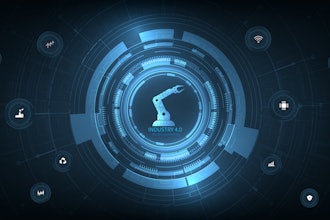The world of distribution has changed significantly over the last decade. With today’s volatile markets, increasing technological advancements and fierce competition for customers, companies are facing the need to adapt or risk falling behind. Essentially, it is now a race to be the most innovative, the most cost-effective and the most accommodating distributor on the market. With e-commerce giants like Amazon and eBay revolutionizing the B2C shopping experience, customers in the B2B space are coming to expect the same rapid order fulfillment, flexibility and competitive pricing. As a result, distributors and manufacturers across North America are looking for new ways to drive operational efficiency, identifying bottlenecks and optimizing processes to deliver greater value to their customers. For this, automation is key.
Most companies already have dependable enterprise resource planning (ERP) systems in place to automate repetitive back office functions, such as inventory control and accounting. However, there are numerous other areas primed for optimization which have yet to receive attention, most notably sales order processing. Currently, more than 80 percent of manufacturers and distributors still process their customer purchase orders by hand. This involves compiling hundreds of orders daily, manually processing thousands of lines of data, before entering the same information a second time into the company’s ERP system as a sales order. Not only is this a time-consuming, highly inefficient use of staff time, but manual processing is also notorious for being extremely expensive and prone to errors, damaging customer retention and your ability to deliver competitive pricing.
In the past, it was clear why sales order automation was neglected. Though the benefits were obvious, the considerable costs and time-commitment involved in implementing a solution — as well as the software flaws — made it unfeasible for most. Today there are numerous solutions on the market proclaiming their ability to automate and facilitate your sales order processing. But which solution is right for your business needs? Consider these four key factors when selecting a sales order automation solution:
No. 1 — OCR or Non-OCR?
Not all sales order automation solutions are created equal. Technology which relies on optical character recognition (OCR) to capture critical order data is substantially less accurate than its non-OCR equivalent. Any obscuring mark or smudge may cause OCR to misread a document, leading to an unacceptable 98 percent accuracy rate. Worse still, this is further exacerbated when working with unique data sets such as part numbers and addresses. While smaller companies may have the capacity and manpower to verify each order before it is finalized, replacing one form of human intervention with another does not resolve the issues of inefficiency and costliness plaguing distributors and manufacturers.
In contrast, non-OCR technology allows companies to treat emailed and printed orders like standard electronic documents, capturing data from them with 100 percent accuracy and zero need for human verification. Once captured, this data then moves directly into the company’s ERP system and is automatically routed to the appropriate channels with total visibility. In the process, orders can be processed up to 95 percent faster with complete precision. Not only does this reduce your order-to-cash cycle time, but it frees up additional staff time to focus on delivering superior customer service, strengthening your customer loyalty.
No. 2 — Will It Affect Your Customers?
With customer retention the aim of the game, your customers must never be burdened for your benefit. Though delivering considerable advantages when fully implemented, certain automation solutions like electronic data interchange (EDI) require a significant level of collaboration with customers to put in place. To introduce EDI, for example, customer purchase orders must arrive in one standard electronic format to be automatically translated into a sales order in your ERP system. Most customers, however, have their own longstanding internal processes to follow when submitting an order. Some may print and fax, others choose email and others still prefer to call their orders in. With their own operational infrastructure in place, they would therefore be understandably reluctant to duplicate effort, creating purchase orders in their own systems before entering the same information item by item a second time into your e-commerce website. Since your business is to serve your customers, expecting all customers to order through your B2B website and asking them to disrupt the way they do business would be completely unacceptable — most likely driving them through frustration into the arms of your waiting competitors.
But there is another reason not to force all orders through your ecommerce website. By sending your customers online, you put them at increased risk of being reached and enticed by your competitors. With their search data saved in cookies, browsers will target your customers for advertising from similar companies, tempting them to comparison shop.
No. 3 — Do You Have The Resources To Implement It?
Automation solutions inevitably have a cost, but some solutions cost more than others. Certain technologies such as EDI entail the dedication of a considerable number of resources in addition to a high level of collaboration with customers. For these, you will need to have strong technical expertise available internally, as well as substantial amounts of money, time and manpower to implement and transform your business processes. So, if you have minimal resources at your disposal, it is crucial to bear this in mind as you review your options.
No. 4 — Does It Work With Your Existing Technology?
The solution you put in place should work seamlessly with your current technology. Anything less would mean discarding and wasting the considerable time and money you have inevitably invested in building your operational infrastructure. If you have already dedicated resources to implementing solutions such as EDI and an ERP system, make sure any sales order automation technology you consider will integrate effortlessly with them.
Ultimately, introducing sales order automation has been proven to significantly improve the efficiency and productivity of your business processes. With numerous options on the market, selecting the right technology to meet your unique needs is crucial. As you evaluate potential contenders, ensure you bear in mind these four key considerations — the solution’s accuracy, its resource requirements, compatibility with existing technology and ability to embrace your customers’ unique business practices. With these factors taken into account, you’ll be able to innovate and adapt to your evolving marketplace. Your customers’ expectations can then be accommodated and your company’s growth secured, ensuring you stay far ahead of the competition.
Brent Halverson is president and CEO of ecmarket, a cloud-based solutions developer and creator of Conexiom — a sales-order and invoice automation solution.























